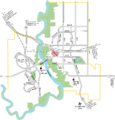Oldman River valley parks system facts for kids
The Oldman River valley parks system is a huge collection of eight parks in Lethbridge, Alberta. These parks are located in the beautiful Oldman River valley, about 100 meters (330 feet) below the city. They were created in the 1980s as part of a special city project. Today, these parks cover a massive 16 square kilometers (6.2 square miles). This makes it one of the largest urban park systems in North America and the third largest in Canada! It's a fantastic place for nature, fun, and exploring.
Contents
Exploring the Oldman River Valley Parks
The Oldman River valley parks system is made up of eight amazing parks. Each park offers something special for visitors.
Which Parks Are Part of the System?
The eight parks that make up this large system are:
- Alexander Wilderness Park
- Botterill Bottom Park
- Bull Trail Park
- Elizabeth Hall Wetlands
- Indian Battle Park
- Nature Reserve
- Peenaquim Park
- Popson Park
There are also two other parks in the river valley, Pavan Park and Cottonwood Park. However, they are not directly connected to the main system.
Fun Things to Do in the Parks
The park system has many cool things to see and do. You can spend a whole day exploring!
What Amenities Can You Find?
You'll find campgrounds where you can stay overnight, fun playgrounds for kids, and picnic areas for eating. There are also many kilometers of trails for biking and walking. Some of these trails are part of the Coal Banks Trail system.
Popular Attractions to Visit
Some well-known spots in the parks include Fort Whoop-Up, which is a historic fort, and the Helen Schuler Nature Centre, where you can learn about local wildlife. Don't forget the amazing High Level Bridge, which is a huge railway bridge crossing the valley! There's even a golf course next to the Elizabeth Hall Wetlands if you like to play.
Wildlife in the Oldman River Valley
The parks are home to many different kinds of animals. Keep your eyes open, and you might spot some!
What Animals Live in the Parks?
You can find various animals living in the park system. These include graceful deer, soaring hawks, and wise owls. You might also see quick rabbits, slithering snakes, and clever foxes. Other animals that call the parks home are coyotes, badgers, and prickly porcupines. In the water, you might spot pelicans, busy beavers, and muskrats. Look for tiny ground squirrels and tall cranes too!
Unique Trees of the Valley
The Oldman River valley has some very special trees that you won't find growing together anywhere else in the world!
The Amazing Poplar Trees
The main tree species that grow naturally in the Oldman River valley are three types of poplars: Populus deltoides, Populus balsamifera, and Populus angustifolia. What's really cool is that these three types of trees can breed with each other. This creates a very diverse forest with many different leaf shapes and branch patterns. It's the only place on Earth where these three poplar species naturally mix and create new kinds of trees!
History of the Oldman River Valley Parks
The area that is now the park system has a long and interesting history, from early settlements to becoming a beloved natural space.
Early Settlements in the Valley
People started to settle in the river valley in the late 1800s. By 1884, about 250 people lived there. However, after serious floods in 1902 and 1908, many families moved to higher ground. In 1912, the area was divided into smaller plots, and by the early 1950s, 83 families lived in a community called Riverside.
From Homes to Parkland
After another big flood in 1953, the Lethbridge City Council decided it was too risky for people to live in the valley. So, they moved all the families out. The city then decided to turn the entire valley into parkland for everyone to enjoy.
How the Parks System Grew
Indian Battle Park was created by 1960. The Lethbridge Nature Reserve was set up near Indian Battle Park in the mid-1970s. In 1980, the Lethbridge Naturalists Society and the Public School Board built a nature center. It officially opened in 1982 as the Helen Schuler Coulee Centre, and its name was changed to the Helen Schuler Nature Centre in 2009.
Starting in 1981, the City of Lethbridge bought more land for parks. They used money from a special project called "Urban Parks for the Future," which was funded by the provincial government. This is how many of the parks we enjoy today became part of the system, including Pavan Park, Alexander Wilderness Park, Peenaquim Park, Lethbridge Nature Reserve, Elizabeth Hall Wetlands, Indian Battle Park, Bull Trail Park, Botterill Bottom Park, and Popson Park.
Images for kids




